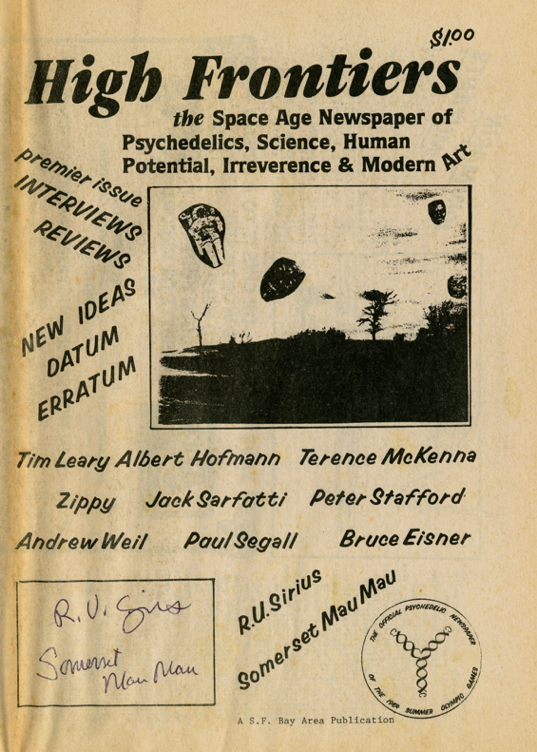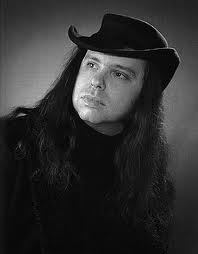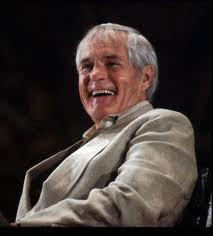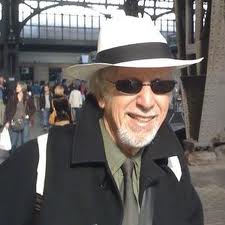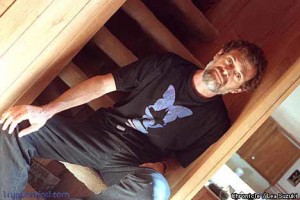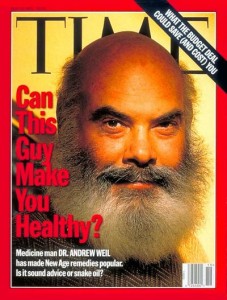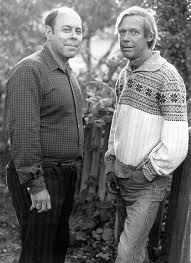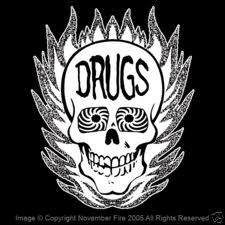I met Marc Franklin (aka Lord Nose) in 1984, when I was putting together a little magazine called High Frontiers (with our first issue, we declared ourselves “the official psychedelic magazine of the 1984 Summer Olympics†— no one else rose up to challenge us for the title). High Frontiers would eventually become Mondo 2000 via Reality Hackers. After seeing the initial edition, edited and designed primarily by myself and Mark Frost (who christened himself Somerset MauMau), Franklin gave us a call, telling us that he loved what we were doing but that we desperately needed some design help. Which we did.

Cover, High Frontiers #2
Marc ended up designing what — for me — may be my favorite edition of the entire 13 year “Mondo†publishing experience — issue #2 of High Frontiers. As he tells it himself, each spread in HF #2 is a visual feast — a “poster.â€Â On the cover of the big hot pink “17†x “11†magazine was the mutated face of Art Linkletter saying “Kids do the darnedest drugs,†along with a three-eared Mickey Mouse holding up a blotter of CIA LSD (along with a few other design elements.). Although we only published 2,000 copies, this edition had both elegance and street cred and put us on the map with alternative periodical distributors and newsstands alike. It also caused at least a few perturbations within the psychedelic community, but mostly, people were bowled over by the sense of art and fun that emanated from its pages.
Employing a uniquely personal and revealing photographic style, Marc went on to work on an amazing project photographing nearly all of the still-living psychedelic explorers in the 1980s and ‘90s. Now there is a gallery showing in Los Angeles that includes these photos — some of them blown up into 24’ x 36″ prints — as well as some very unique “nature photos†that add to the aesthetic of the presentation.
If you’re in or near LA, make haste — go right now to SPF:a Gallery where the exhibit will be up until the end of 2011. You’re in for a consciousness expanding experience.
In the following interview, I do two things. In Part 1, I reminisce with “Mr. Nose†about our experiences with High Frontiers. Some of this material (and more – we’ll be doing further conversations) will be used in the Mondo 2000 History Project book and website that will tell the story of that historic “psychedelic cyberculture†publishing project through the voices of as many of the contributors as I can rope in. And in Part 2, I talk with Mr. Franklin about his amazing photography project.
Incidentally, if you follow all the links from this conversation, you can get a full education in the worlds of psychedelic research along with these colorful anecdotes.
PART ONE:  THE “HIGH FRONTIERS/MONDO 2000†STORY
MARC FRANKLIN (LORD NOSE):  I found High Frontiers #1 in a head shop on San Francisco’s Haight Street called Pipe Dreams. I grabbed it immediately and began reading it and then I bought it. I discovered that you had put a little notice in there about people that wanted to help to contact you, so I hurried home and immediately called the number listed. I realized that it was an opportunity for myself to kind of assist a nascent publication that had amazing potential. I thought: this is a hot idea! I love the idea.
You and Somerset MauMau came over. Â I was living in a house on Broderick Street close to the bottom of the Panhandle in San Francisco with my wife Betsy that we shared with the owner, Don Emery. Â Don had bought a wonderful 1906 Queen Anne that had been completely renovated. It was just totally luxurious.
I remember very vividly you guys arriving.  I’ll never forget what you said to me the very first moment we met. I had opened the door and you said, “We don’t look like what you’d expect.†(laughs). It’s funny also because nine years later someone else said the very same thing when I first met her…
I had designed numerous publications before then in New York. I had been working professionally doing that. I had also worked as a photographer. I had done the photography for the 1974 Mobil Annual Report. Back then, Mobil Oil was the fifth largest corporation in the world. However, photographing a phosphate strip mine operation in Florida really radicalized me. I thought: whoa, that’s the wrong direction. I’m not going in that direction. I’m going as far away from that as possible.  So High Frontiers was the perfect vehicle — the perfect opportunity.
Anyway, after we met, we had agreed to get together and hang out. We wound up going one day out to Tennessee Valley in Mill Valley. It was MauMau, myself, you and Betsy. We had quite an experience with trying out for the first time “ecstasy†(MDMA) and — we sort of all bonded. That is, with the exception of Betsy.
MDMA was a change from every psychoactive I had previously experienced. It was certainly different and, of course, it was not a psychedelic. It was where we dropped the “I/Thou†and suddenly we’re all these big amorphous fingers on one hand. We all felt so damn good. And, then there’s Betsy off alone. Betsy was dealing with the fact that she needed to leave me. And this experience gave her the space she needed to deal with that. So the three of us were tight and Betsy was dealing with her own stuff. And I felt really strange about that, but at the same time, it was perfect.
RU: You were having a good time anyway.
MF: Yeah. I mean, it wasn’t that it was a bad time for her… but it was a difficult time for both of us, generally.
HIGH FRONTIERS CONTENT
MF: Â The subject matter was something that was quite dear to me. I had come out to California to continue my study and practice of shamanism. I mean, that was the end-all, be-all for what I was doing. I was really learning about healing modalities, and divination. One of the aspects, of course, was psychedelic shamanism. So it was just like hand-in-glove. It was like here the universe is providing me with an opportunity that I could not pass up. Looking back, at the time, that it was a very good fit.
We all seemed to have that same kind of spark. There was some spirit there that really grabbed me immediately. I thought: this is beyond a job… this is not a job. This is a lifestyle. It was beyond anything one would normally consider. It felt so good. And right.
At the same time, I was undergoing emotional turmoil with the breakup with Betsy. Â So it was a pretty interesting sort of rebirth — a death of one aspect of myself and the birth of another. It was quite a challenge to shift — to sort it all out. It was almost like a landlubber suddenly getting onto a ship. You have to get your sea legs. You’re kind of walking along and suddenly you’re thrust out onto a moving vessel in the throes of a storm. It’s either sink or swim. You’re either going to be able to do it or you’re going to fail. And it was not a matter of failure. It wasn’t in the cards. There was some important reason for it all happening.
DESIGNING THE MAGAZINE
MF: At first, I didn’t have an idea of what I would do with the design of this new magazine. I mean, I had some thoughts about it.  I had taken advanced graphic design classes with Milton Glaser and Henry Wolf and Clay Felker from New York Magazine when I was in New York. I was really crazy about publication design.
When it came time to conceptualize the magazine, I decided and told you and MauMau that what I wanted to do was create something where each spread was like a poster.  Each page would be — in and of itself —something really inspired. I said, “When you enter into that non-ordinary reality, it’s not tepid. That is so dramatic.†So I wanted to kind of utilize the knowledge I’d gathered to do something that was really aesthetically grabbing. At that point, psychedelics had such a bad rap… you know… had a lot of baggage because it was all over the map in terms of how people were using them and the results. And I felt it was really important to do something in terms of the neopsychedelic notion.  It had to be strikingly different. To boot, we had no real budget, so I had to rely on my ingenuity. Hitting upon the Xerox copier—like the Punk fliers that were around then — allowed for a cheap workaround. Especially when the sympathetic clerks realized what I was doing. Most times they would not charge me for each copy I had made… usually because I would spend hours on the machine, selecting, resizing, cropping, collaging and experimenting all before them. The creative process is not linear— and I am definitely not a left brained sort… without intuitive spontaneity the results look quite dismally plain. Ordinary. Our magazine required exceptional graphics.
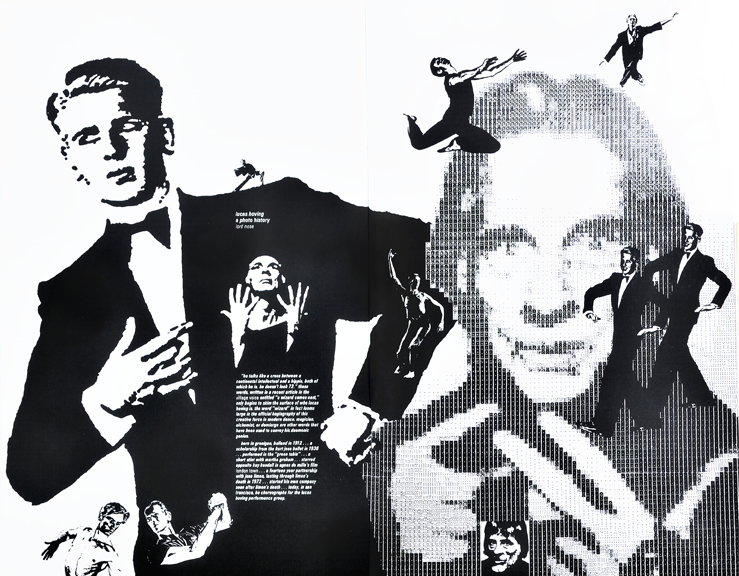
Choreographer and dancer Lucas Hoving in High Frontiers #2
RU SIRIUS: Â It really pulled off a new aesthetic that was really hip and really irreverent and appealing to young people.
MF: Â At the same time, it was different from the then current design standpoint. None of the stuff I do is ever trendy. Actually, there’s a certain inherent classicism so the project looks as fresh today as it’ll look thirty years forward.
RU: And yet that second issue sort of fit in with the punk vibe that was around.
MF:  Oh, yeah.  Living close to the Haight — and what with all of the punk bands in San Francisco and that graphic look that they had — I wanted to take advantage of that because I liked it. There was a freshness to it. A certain rawness. A haphazard spontaneity. At the same time, the Punk aesthetic was generally pretty rough edged. So I took a pinch of that influence and morphed it into something else. Kind of thesis, antithesis… and then you get your final product — a unique synthesis.
TRIPPIN’ BALLS
MF: Every weekend we went out there to that cove and spent the entire night there.  It was the most extraordinary period of growth, because we were getting to know ourselves from a very different point of view. And we were getting to know each other—plus, we were getting to know other people as well. I could not help but think we were pretty mindful of the fact that we were doing something important with the magazine… without feeling self-important. Carol (High Frontiers attorney) had said to me one day: “You’re dreaming for the rest of us.†She was correct.
RU: Usually it was you, me, and MauMau… and we’d sorta pick out one or two people and bring them out… (laughs)
MF: Yeah… and totally freak them out. (laughs) They were never the same after that.  Reflecting back on it — that was really ballsy. But at the same time, it was done with such a good intention and good-heartedness— and a sense of humor. But mostly, in innocence. I know we were genuinely innocent because we were never trying to impose ourselves on these other people. I’ve had so many weird, peculiar experiences with some of those strange people who had come through the doors — especially those power trippers that came through.
RU: You mean during those times, or at other times?
MF: Yeah, during the High Frontiers period. One day I had an unusual experience with some psychologist that I met through the magazine. We went out there to the Valley together.
This I’ll never forget: Â I had driven over from Berkeley. As soon as we had gotten high, suddenly this other entity appeared on the scene. Now, it became abundantly clear I was in danger. Psychic danger. This became a battle. It turned really weeeiiiird… I mean really, really weeeiiird…
Now when I say weird, I’m talking like vampire weird where I knew that there was something extraordinarily wrong with his intention. I recall that we split up during this experience. A bit later, when we met on a trail, he said to me something along the lines of: “thanks for the ride.” It was clear he meant he had somehow… I don’t know what he done to me psychically. I have no idea what happened, except that… it was very, very, very weeeiiird. Suddenly, still out in the ozone, I’m leaving the place alone. How he got back, I have no idea. And I never ever heard from him again. (An analogy today: he downloaded files without permission… a “sneak and peek†rummaging through my mind.)
RU: Â (laughs) Yeah, there were some spooky times there.
MF: Â There was one time, you and I came back to Mill Valley, and it was the same kind of stuff. Â This insanely weird stuff going on. You can’t talk to someone about this because they’ll think you’re absolutely bonkers. Guess we were/are?
RU: Was that the day we came back to Mill Valley and there was a guy in the burrito shop in front of us who was naked?
MF: Â No, I don’t remember that.
RU:  (laughs) I think that was you, me and MauMau…  but you had split back to San Francisco already. And it was one of the most intensely strange excursions. We were back in Mill Valley, and we were like: Are we in a Philip K. Dick novel? Is this the same universe we were in before or a parallel universe? And then we walk into the burrito shop and there’s this guy in front of us completely naked. (laughs).  Then I knew we had come down to a different universe.  I went to a phone booth and called Terence McKenna about it.
MF: I remember one.  I think it was the first time that we had spent an evening with LSD, and fortunately at that time we were able to get some really clean stuff and it was one of those spectacularly diamond clear experiences. And at the end, we had been given some DMT to experiment with… the first time that we did that. And that was… a remarkable revelation. I love DMT.
RU: I think we had actually sort of been debating — (both laugh) — earth vs. space or something like that. And then we sat down and smoked the DMT and that just kinda splattered rational argument into a zillion pieces. None of it mattered.
MF: That was when we began the quest. The quest for using multi-molecule routes.
RU: Synergy.
MF: The synergies.  I told Sasha (Shulgin) that the best combination I’d found was 2cb and DMT. He was amazed…. couldn’t believe it. For me, that was the best one. I liked that combination the most… of all the trials run.
RU: Yeah. They both are highly energetic.
MF: We both really liked the DMT.
RU: Â Yeah, that was a real love affair for me.
In the process of designing the second issue, I remember you doing excursions for inspiration almost like for every image. Is my memory false, or…
MF:  (laughs) No. It’s very true. You would bring me an article. And I’d read it and then try to get a handle on it. What was it exactly that had to be brought forth visually to make it worthwhile — because it couldn’t just be a simple illustration. That’s not what it was about. It was more a matter of finding the essence of the story and then bringing that out visually. Like the amazing story we had by Ram Dass gotten from Peter Stafford’s  “Magic Grams.†[unpublished book manuscript] It was a terrific piece and I think the illustration really, really worked on numerous levels.
MAKING & MARKETING THE PSYCHEDELIC MAGAZINE
MF:  I’d split with Betsy in July.  I was living in a loft in the Tenderloin. I had no money. You said, come to the San Francisco Symphony with me to sell season tickets. Here I am — tongue-tied, totally introverted… but flat broke. When I began with High Frontiers; I was about as insular as you can be.  My wife had been working in the world.  I very much liked being quiet, being in the wings, and not having to assert myself. And suddenly, I’m thrown out there to the lions. I’m out of money.  I said, “Well, I’ll give it a shot.”

High Frontiers #2 Centerfold
For the first two weeks, I didn’t make one sale. Not one. It was strictly commission. I was determined to succeed. It was important for me to learn how to communicate verbally. As you know, I have this enormous capacity to persevere. Finally, on the 15th day, I made my first sale… and then I started making at least $200 a week! You know, that was not bad considering we only worked four hours a day. Suddenly, I learned how to speak with strangers, how to get them to see my point of view. I realized that I enjoyed it. It was like learning that while all my life I had never played baseball — but when I was forced to play, that I loved the game, and was good at it to boot.
I remember that you and I moved into a house in Berkeley, a duplex. Â We were gathering the material for a magazine with lots of people coming around. It was coalescing into quite a scene.
That certainly was fun because at the same time it was during the reign of Ronald Reagan and here we’re doing something so completely opposite to mainstream, conservative America. How could we not just adore what we were doing?
Here we’re working towards a lofty goal — the excitement was really, really palpable. Creating this magazine was worthwhile. There was finally a reason for being…
I had set up a studio in the back bedroom. You were living in the living room. Your mattress was a simple piece of foam rubber that you slept on. Â No furniture at all. Then, suddenly, you got together with Alison (Kennedy aka Queen Mu)Â and began living in the antique-laden lap of luxury up in her place in the Hills.
THE LA TRIP
RU: Â Not long before we had the issue printed, we went down to LA. Â That was a great trip!
MF:  I remember when we interviewed Timothy Leary — we finished interviewing him and we were talking afterwards. His wife, Barbara, came out and she said she was going to the gym. And he said, “Can I join you?” And she said something along the lines of… “no.†And we realized Barbara ran the show. Tim was just completely shot down. “No, you can’t join me.” I was shocked. Here’s the great Tim Leary and look at the way he’s…
We went to see Tommy Retitg [ed: he was Timmy in the TV show Lassie] That was the fun one. We went to his house — his apartment in Marina Del Rey… He was a nice, kind person. And he turned us on to some guy that had created a little booklet of materials for replenishing your neurochemicals if you use these miraculous molecules. We published some of it.
And then we went to see the publisher Jeremy Tarcher in Beverly Hills. In another wing of the house, his wife Shari Lewis was having singing lesson. We were talking with Jeremy, when Shari comes out and says: “You weren’t here, were you?†She was so embarrassed.
I remember driving down to Manhattan Beach to meet Durk Pearson and Sandy Shaw. There was a heavy, low fog. Looking up, one could see the arcs running between the insulator and the wires as we passed Los Angeles Power and Light’s generation plant.  Just like in Blade Runner. It looked like we were entering Hell. Arriving in their neighborhood, in the street, there was Sandy screaming into a two-way radio… announcing our arrival. Apparently she’s deaf.
RU: Wasn’t she dressed in…
MF: Â Black leather.
RU: I remember they were in army fatigues… camouflage. Sandy screams into a walkie-talkie: “They’re here!â€
MF:  They had this green pallor about them… oh, my God. I have a photograph of them with him opening that refrigerator filled with all those hundreds of nutrients.  What a strange couple they were…
RU: They had, like, the strongest weed I’d ever smoked and then we all sat down and watched some weird Masterpiece Theater spy show that they were really into . (both laugh).
Remember what happened when we returned from LA?
MF: Oh, yeah. We came back and suddenly the house was transformed. I remember that the guys who were living in Marin… MauMau and Amalgam X and so on had brought over all kinds of pillows and coverings. But first they had destroyed the house. It was sort of like destruction and then creation.
RU: MauMau had basically eaten all of the magical molecules that we had in the refrigerator… everything at once.  I think he drank a jug of wine first.
MF: …Then just completely destroyed everything. And then they came back and they fixed everything.
RU: Â Things started to split up in various ways pretty quickly even before the publication of that issue. Â There were a lot of really different characters involved.
MF: Right. Mau au and X sort of split off and stayed mostly in Marin while we were in Berkeley. Â (Amalgam X! Â What an amazing character! What a genius for comedy!)
We stayed in Berkeley and they were doing their craziness over there. It was very interesting. From a sociological standpoint, the difference between what was happening in Marin and what was happening in Berkeley was pretty interesting. Berkeley was much more cerebral, more intellectual.
RU: (laughs) Yeah, we were like two tribes. We were all Jews over in Berkeley. (both laugh) We tried to keep it together. (both laugh).
……………………………………………………
PART TWO: THE TRANSPERSONAL (PSYCHEDELIC) PHOTOGRAPHY PROJECT
RU: Â So you started this almost lifelong project of photographing individuals who were involved in psychedelics in some way. Describe how that came about.
MF: Â Well, I bought my first Nikon F, an SLR, in 1961, while a sophomore at Pratt. I worked in a paint store. For 75 cents an hour. So you can imagine how long it took me to make $200 to buy the camera. I scrimped and I saved, but I bought this camera. When I discovered the “camera,” I realized that I no longer wanted to be an industrial designer. No longer was I interested in designing racing cars. Thus began my lifelong love affair with creating two-dimensional images.
In 1988, I spent the entire summer in Europe. I called Albert Hofmann… it being the 50 years since the first time that he created LSD-25… I called him and I told him that I wanted to visit him to do a photograph. He said he would welcome that, but he couldn’t do it then.  I think he was having a health issue. I knew he was coming to Santa Rosa that October for the Association of Transpersonal Psychologists annual meeting. (Stan Grof’s group).
I arranged to meet him there.  I photograph him on a Sunday before the event began to catch him fresh. The next day I had the film processed. That evening, I made a print — went back up to Santa Rosa, presented Albert with the portrait, and I explained to him that I plan to photograph all of the living psychedelic pioneers.”

Albert Hoffman, photo by Marc Franklin
At this time, the US government was running a stupid ad campaign, truly asinine propaganda: “This is your brain, this is your brain on drugs.” Showing a fried egg. Preposterous. Lumping psychedelics together with speed, opiates, and all the myriad other drugs of abuse. I thought, “You know, that’s such a load of horseshit. I must do something about that!”
Knowing full well that so many wildly creative, intellectually robust, well-rounded individuals had seriously and irreverently undertaken working with psychedelics as healing agents, for divining the future, for creativity, for re-creation… they weren’t the burn-outs, the walking wounded, riff raff, that the government would have you see — but rather they were society’s most intelligent beings. These were the leaders in every field — visual art, music, science, literature, religion, human consciousness… the crème de la crème! “I’m going to portray these people how they are. I’m going to dismantle that poisonous propaganda lie visually. That is what I do best.†Thus began this multi year project.
That Monday, I called Richard Evans Schultes at Harvard explaining my plan. He agreed to sit for me. I quickly made arrangements to get to New York. Then I phoned Allen Ginsberg, who I had known from my Yippie days in NYC.
Turned out that Ram Dass just happened to be in New York City, so I called him. From Manhattan I drove up to Cambridge, spending a marvelously insightful day with Schultes at Harvard’s Botanical Museum. That was quite something. All RES did was rail against Michael Dukakis, who was then running for President. I mean, this guy was not a Republican — he was a Tory! [Laughs] What a character.
RU: Your photos have a particular look, a particular sort of framing mechanism that brings out something. Did you have that in mind right from the start?
MF: Before I even went to photograph Albert Hofmann, I knew immediately that this project was going to be a matter of capturing… delineating the soul. The photographs themselves had to be “psychedelic.†But certainly not like anything heretofore seen, and not obvious. As a point of departure I used the cliché: the eyes are the gateway to the soul. I love clichés. Why? Because that gives me much ammunition to work with. Employing a strong vision with hackneyed, trite, severely overused clichés, but in a new manner — suddenly you’re a genius, you know… because everyone before has attempted to do this before, but failed. So if one can achieve it in a different way—then there is that satisfying “ah ha†moment.
ACCESSIBLE, BUT DENSE
What differentiates my portraiture from the mass of snaps is that I photograph the inner person… not the exterior husk. I’m able to “grok†people… instantly. That’s what these transpersonal portraits are—a concise distillation if you will. A symbol. More than anything else, without the person’s active participation in perpetuating their ego bound mask. Suddenly, without their intervention, it’s the most precise liberation of that individual — a distillation of their vital essence, visually. No need for words of explanation, either.
Generally I would just call someone and say, “I want to do a portrait of you for this ongoing project†or simply, “I want you to come over.” Like, I phoned Wavy Gravy, all right? Wavy and I have known each other for many years. He is familiar with my work. So he came over to San Francisco. The result of this collaboration: I have a portrait of Wavy that is unlike any others taken of him. Curiously, some particular but crucial element of the portrait had escaped my scrutiny. It had eluded me for 23 years! Only when I had these 24 by 36 inch prints made, did I discover that there’s a teardrop running from his eye! Wavy’s particular expression — the quintessential bittersweet clown image, smilingly sad. But with a tear drop. Each one of us has an inherent sadness that is overwhelmingly obvious if one is sufficiently perceptive. This is the human condition.
About the framing. No, it is not at all arbitrary, but rather the closest I can get to someone’s face with a particular lens that I have chosen to use. It is a 105mm lens — a portrait lens — to avoid facial distortion. Use of a shorter focal length lens in close would make the sitter’s nose become the size of a basketball, their eyes like peas. To emphasize the eyes meant I needed to crop out a portion of the face. Since hair is the least important personal feature, it’s outside of the picture frame in these images. The sitter’s chin is so much more important. But it is the eyes that are of paramount importance.
RU:Â Right. Those are real clean pictures.
MF: Of course. After these many years my technique has become painstakingly perfected. One would hope so. [Laughs] Also, as one stricken with the curse of perfectionism, I knew that with black and white photography, especially these close-in portraits — that the most important item you have is the photographic negative. Not having had my own darkroom since 1972, I always had to have a pro lab process my film. Always I sought out the best possible lab, paying top dollar to have my film processed. Because I knew that in the future, the only thing I would have to work from is what I had created in the past. I’ve got to have good material. If I’m going to spend the time to do it; it’s got to be done well. Likewise I’ve also always sought out the best equipment. I found the best lab in San Francisco when I was working with the Nuclear Freeze movement in 1983. Not inexpensive, but hang the expense if they do a great job. In the grand scheme of things, film costs and processing expenses are trivial. I was not looking to save money. I was looking to have impeccable negatives to print from.
This summer, I needed to have the negatives drum scanned. Fortunately, I was introduced to a superb craftsman, Steve Philips. He lives here in Santa Cruz. Steve works with many of the National Geographic photographers, along with the world’s top wildlife photographers represented by Minden Pictures, a stock agency in Watsonville, of all places. Publications require high quality input. Minden uses a high-resolution Heidelberg drum scanner to digitize the film images of their photographers. Steve provided superb scans of my negatives at a very reasonable price. (One reason was the cleanliness and quality of my negatives—a result of having chosen properly years ago.) His work is exceptional… His long term printing expertise was what allowed me to make 24 x 36 inch prints from my 35 mm negatives, with ease. It’s amazing when you consider this: we’re talking about a 35 mm negative that is one inch by one and a half inches. That means it’s a 24 times blow-up. That’s pretty extraordinary when you think about it. Can’t be done readily with analog photography. The image would disintegrate. But these digital images are absolutely sharp edge-to-edge. With judicious editing in Photoshop, they are totally clean of unnecessary artifacts. Dramatic. Majestic.
RU:Â Let’s talk a little bit again about some of the people you photographed.
MF: Claudia Naranjo was the second person that I photographed. Afterwards, I flew off to New York to see Allen Ginsberg. From Northport, NY I called him. “Oh yeah, come on over. Of course. Of course, come over.” When I got to New York City, I called him again to arrange a specific time. Allen said, “I can give you five minutes.” I said, what are you talking about, five minutes? When I arrived, he says, “I’ve got five minutes for you.” “Five minutes? It’ll take me more than five minutes to unpack my camera.” An hour and a half later, I was finishing up.
A year later, after I gave him a print, he asked, “Why is it so sharp?” I said, “Allen, I’m a photographer. I know how to focus. And I use Nikon lenses.” “Oh…”
To preclude the sitter’s preconceptions about what was about to happen, rarely, if ever, would I show them a finished portrait from the series. Not until the session was completed. I didn’t want them to know what I was about to do. All I asked of my subjects was to look directly into the lens, to not smile, and most importantly — to continue breathing.
Fast forward to December 1988 and I realize, “Oh, look who’s going to be playing at the end of the year — The Grateful Dead.” I called upon Dennis McNally, their publicist, to make the needed arrangements. After seeing the portraits I had with me, Dennis remarked, “You can only go in alone. You can’t bring an assistant.” (You can’t do this. You can’t do that.) And I’m saying, “But I typically have been photographing everyone with available light, using daylight.” He says, “You can only photograph them at the concert just before the performance.” Despite the conditions, I got exceptional portraits of Jerry Garcia and Bob Weir. The other band members did not see fit to sit for me. To this day I do not know if Dennis ever mentioned to them that I was doing portraits.
Nearly everyone I contacted agreed to sit. The only exceptions were Mountain Girl and Ken Kesey. Caroline Garcia (Mountain Girl) did not want me to photograph her, but she brought me to a Dead show as her date…
Seems like Ken Kesey, his wife Faye and I danced for months. For hours on end, I would be on the telephone with them. Eventually I managed to photograph of Ken in SF when he was drunk on sloe gin… but it’s not the same. You know? I didn’t want to show that side of him, the Trickster that he was.
Following a peyote hunt in the Mexican desert along the Tropic of Cancer with the Huicholes, in March of 1989 I went to see Oz (Oscar) Janiger in LA. He said to me, “Make my house your house. Here’s my Rolodex. Consider it yours. Who do you want to meet? I’ll call them for you.” Oz was so generous. He was very excited about the project. He loved the portraits.
During that visit to LA, I went to Nick Bercel’s house. Nick Bercel was the psychiatrist that gave LSD to spiders. He was apparently the first individual on the west coast to take LSD. Actually, not to take LSD, but to administer LSD. This was 1949. Nick told me a really funny story of how he got an unnamed divinity student as his subject, he broke open the Delysid ampoule and he put it into the distilled water. Back then, like nearly every adult, he was a cigarette smoker. Sitting back across his desk from his subject, the man remarked, “Every time you raise your voice, you get larger, and every time you lower your voice, you get smaller.” And he tells the subject that the same thing was happening to him. He said he must’ve spilled some on his hand and that transferred when he was smoking the cigarette. So he said the next day, he took LSD to discover the effects for himself….
Later, I went up to Tim Leary’s house. Arriving early, I waited in the driveway for Tim to come back from the gym where he was going to be with (his wife) Barbara. I dozed off. She honked the horn. I wake up and make my way to the house. She said, “Do you have any photographs to show me?” I made the mistake of showing the portfolio of portraits that I always show afterwards. Barbara then said, “Hold on a minute, please.” About 20 minutes later, Tim comes back freshly shaved, now dressed in a suit jacket and tie… he had been in a Nike running suit.
I asked, “Barbara, will you allow me to photograph you?” She said, “Absolutely not. Your photographs show everything.”
But Tim loved his portrait. He became one of my biggest fans.

Timothy Leary, photo by Marc Franklin
After the session with Tim, I’m leaving to go back up north to my home in San Francisco. Earlier I had made arrangements to drive up to John Lilly’s house in Malibu. It was March, so the sun is going down fairly early. For these portraits I’m using available light… Driving up the coast along the ocean, just as I am about to turn onto the road to get to John’s house, a humpback whale spouts! Greetings from Malibu.
Arriving at John Lily’s house, I spy John standing in his bathrobe, pajamas and slippers. With a weeks’ stubble on his face. He’s got a cigarette dangling from his mouth. John says to me, “Where do you want me?” “John, we better hurry up, because we are fast losing the light. Let’s do it right here.” With that, he opens his mouth, and the cigarette tumbles out. “Oh, this is going to be a very interesting time, very interesting.â€
Well, I photographed him in the driveway. My three exposures. Boom it’s done. Afterward, we go into the house. He introduces me to his daughter, Nina, and the others that were there. At a certain point, he looks at me and says, “Now, you’re the psychedelic photographer. Do you have any drugs on you?” I said, “Well, John, as a matter of fact I do. Some liquid peyote that I brought back from Mexico. You’re welcome to have some.” At that point Nina pops up, and she says, “John, you just had a steak. Let it digest.” (laughter)
Back home in San Francisco, I compiled a master list of the individuals all around the country I wanted to include. I mapped out an itinerary, starting with a second trip down south to LA. I decide May was time to begin this major road trip. Seven weeks, eleven thousand miles as it turned out. Oz Janiger assisted me in LA, arranging appointments with all the locals… From LA, then onwards to Tuscaloosa AL (Humphry Osmond) to Tennessee (Stephen & Ina May Gaskin), Maryland (The Spring Grove Hospital crew), NYC (Joan Halifax, Harry Hermone, Howard Lotsoff), Boston (Grinspoon and Bakalar), Toronto (John Beresford),back down to Pittsburg, and out to Lawrence, Kansas to stop and see William Burroughs.
In the process of setting up my itinerary, I called William Burroughs. His secretary, James Grauerholz – we had known each other for years — said, “You know, we want to see you, but we’re going to be in Switzerland in May. William’s shotgun paintings are going to be on exhibit. But we really want to see you. Instead of coming and seeing us on the beginning of your trip, come and see us at the end. We do want to see you – definitely. Come by. However, you know, William hates having his picture taken. And he hates psychedelics. But we want to see you, so please come by.”
I didn’t think anything much of this conversation… I just marked it down that I had to go see William Burroughs in June. The real trip began when I went to see Humphrey Osmond, who lived in Tuscaloosa, Alabama. I was to go all through the country, eventually driving up to Toronto for John Beresford. It was his insistence and acid that Michael Hollingshead used to turn Tim Leary on to LSD (before that he was sticking with psilocybin). I motored up to Tennessee to The Farm. While I was at the Farm, Ina May Gaskin asked, “Aren’t you tired of photographing only men? This is a project primarily of men.” I said, “You’re right!” “Would you like to photograph midwives?” I agreed, “I’d love it.” So concurrently, I would be photographing midwives. It was a beautiful balance for me.
Enroute to Baltimore, I stopped in North Carolina to photograph Weston LaBarre. In Baltimore, I photographed Rick Yensen and all of the people, except Stan Grof, that were at Spring Grove Hospital… This group of psychiatrists and psychologists had done ground breaking work, legally, with psychedelics at Spring Grove Hospital.
Then I drove to Manhattan. “Joan Halifax wants to see you,” my friend Jeff informed me. “Joan Halifax wants to see me?†Last time I had seen Joan Halifax, it was to interview her for High Frontiers magazine. When Joan had opened the SF hotel room door — she bit my head off. She snarled, ‘You came in here thinking I was an advocate for psychedelics? Well I’m not!'”
At the Open Center, there’s Joan at the back end of the space. She sees me, she pops up, comes running towards me, throws her arms around me and gives me a big wet smooch! “What do you want? What can I do for you?” I said. “Joan, uh… I’m here to photograph you.” She asks, “Where shall we do this?” I said, “Well, we gotta do it outside quickly. Again, the light was fast fading. “Let’s take two chairs outside on Spring Street and we’ll do this.”
Sitting across from Joan, I’m ready to take the first exposure. Now you have to understand, when I photograph, I take two or three snaps. That’s it. I don’t use the shotgun approach. I’m very mindful… four photographs, at the most. I’m selective. Very very judicious. I use the full frame of the camera. So, I’m ready to fire off the first exposure when suddenly someone’s tapping my shoulder. He inquires, “What film are you using?” [Laughs]
I arranged to photograph Lester Grinspoon at Harvard. I said, “Lester, I’m going to be here during this particular weekend. I’m going to get to New York and then I’m going to drive up to see you.†He says, “No problem. I’ll be there.” I drive all the way up to Boston — 200 miles — a four hour drive, right? He’d gone to Portugal! I had to drive back to NYC empty handed. I arranged to return the following week.
On to Toronto where I’m going to see John Beresford, MD. Talk about a character!  He was such a sweetheart. I go up to his office on Young Street into this modern high rise building. He’s dressed in a three-piece suit with a tie. “Where do you want to photograph? I answered, “Well, I’ve been using available light outdoors. Let’s go down to the street.” In the elevator, he starts disrobing! Takes off his jacket, takes off his tie, takes off his vest, takes off his shirt. Takes off his t-shirt! “I want you to see something.” He’s got this ‘happy cross’ hanging around his neck. You know, a Christian cross with a smiley face? He put the smiley face on a cross. John told me, “What’s wrong with the cross is that it’s a symbol of death and destruction. We’ve got to put a smiley face on it to make it happy.” He gave me one. I have it. Sterling silver. What astounding eyes this guy had. What a heart…
From Ontario, I drove to Pittsburg, Pennsylvania to photograph a midwife there. Continuing my quest, I headed out to Lawrence Kansas to see Burroughs. 26 hours straight, I was on the highway. I get there at 11:00 am. I bound up the stairs to see James Grauerholz. He’s there. I show him my portfolio. We chat and catch up. “Hold on a minute.” James is on the phone. He looks at me and says, “Would one o’clock be good for you?” “Yes, point me in the direction of a health food store, I’m starving…â€
We have a little caravan of cars heading off to William’s house. Me, in the California plated car, I was followed by a local police cruiser. [Laughs]
William’s tiny house is threadbare, literally. He’s got a small wooden table, no carpet… nothing on the walls. No furniture in the house beyond the chairs we were sitting on. It’s 98 degrees with 99% humidity. We were sitting at the table and talking. I show him my portraits, because I knew that I was not going to photograph him. We’re talking about all sorts of wide-ranging, interesting subjects. “Would you like a drink?” he says, as he walked over to his refrigerator. “What are you going to have?” ” A Cuba Libre.” I noticed he had a Dos Equis on his refrigerator door. “I’ll have that Dos Equis.” I knew that I could sip on that for two days if need be… appearing quite social enough. Because if I drank any alcohol to speak of, I would fall over and collapse from the sheer exhaustion of the crazy drive…
William belts back several of these drinks faster than I could blink, right? He takes his bony finger and he points it in my face. “Tell me something. How long do these photographs of yours take?” “Oh, approximately a sixtieth of a second.” “You’re on.”

William S. Burroughs, photo by Marc Franklin
RU: So let’s talk about this show down in LA.
MF: The show is an experimental mix in a non-subtle manner of large-scale transpersonal portraiture and events, countered with portraits of the natural world. All my work is essentially psychedelic portraiture, be it hydrogen-bomb scientists, harbor seals, redwoods or ticker tape parades. All the same. Brute force is required to bust through the din… Today we are swimming in a veritable stew of images, an onslaught overwhelming our visual sense gate, each vying to be seen, to inform us. Beautiful images are healing. Aesthetically uncompromising photographs allow me to speak directly to their “being†introducing to the beholder novel concepts that verbally would never be considered, accepted… let alone understood.
Nature as healer. That remains the guiding concept of mine… A number of years back I began photographing plants and trees seriously as healing images for hospitalized veterans. (Neuropsychoimmunology: images used to heal.) I began with the process of looking carefully—and seeing. Seeing the world, interconnected, interdependent, not as separate “thingsâ€â€”but as process.
When first viewed, the large-scale prints of the exhibit look weird, “unreal†to the uninformed.  Because they’re not as sharply focused throughout as one normally views this consensual reality. To bust through deeply embedded prior preconceptions, shallow focus is employed for emphasis — to delineate particular aspects of a flower. It’s essence. The “isness†of the flower.
The trees flow, they sway, they shudder, convulse, shake, spin. Animated, yet are captured within a “still†frame. This contradiction serves well to help one in questioning “reality†— acknowledging just what we do not know. Disorientation causes one to feel: “Wow, what feelings come up from seeing these images.” Each a little miracle.
The psychedelic pioneers’ portrait series meshes well with the images of nature, because all of my work is that of a portraitist.
People, animals, plants, events. All the same, really.
Employing XYZ, the concept of dominant, subdominant and subordinate, each visual element fits perfectly within the rectangle formed by the camera. This elemental underlying concept, XYZ forms the basis for all works of art: painting, sculpture, graphics, poetry, film, music, literature, photography…Â
The Marc Franklin  Beyond: A Transpersonal Photograpy Exhibit  at SPF:a Gallery in Los Angeles until the end of 2011

